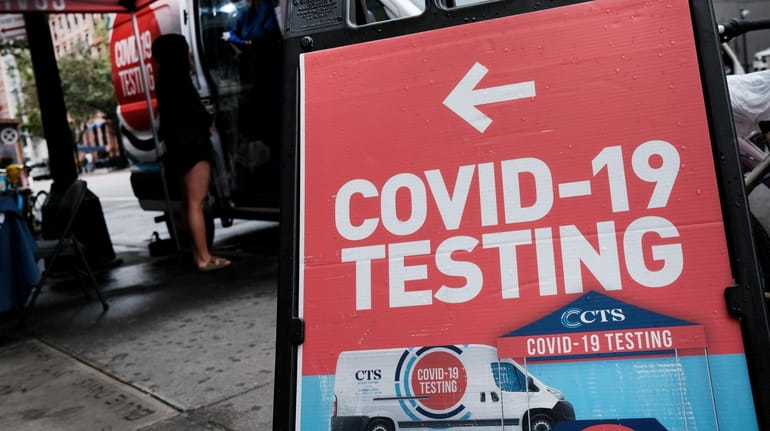What to do if you test positive for COVID-19, have symptoms or were exposed

A pop-up COVID-19 testing site stands on a Manhattan street in October. Credit: Getty Images/Spencer Platt
As the omicron variant spread across the region, New York State broke its record for reported new daily COVID-19 cases and Long Island was consistently recording the highest seven-day average of new cases in the state.
What should you do if you have symptoms of COVID-19, test positive or were exposed? The Centers for Disease Control and Prevention has updated its guidance in recent weeks. Here's the latest.
If you’re feeling sick
If you have symptoms of COVID-19, the CDC and New York State say to get tested and to isolate yourself until you know your results. The CDC recommends avoiding public transportation and leaving home at all unless it’s to seek medical care.
Where to get tested
Many pharmacies, urgent care centers and other medical offices offer COVID-19 tests. Some locations require making an appointment ahead of time or have other specific requirements. Check out our full guide here for where to look for a test. Some options:
- New York State has a searchable tool you can use to find a test site near you.
- Try scheduling an appointment online at places such as Walgreens, which offers drive-thru testing, or CVS with the online scheduler.
- New York City-run test sites are open to anyone regardless of residency. You can find one with the resources on its website, which include mobile, pop-up and rapid-testing sites.
You can also consider using at-home test kits, which are in high demand. The U.S. Food and Drug Administration issued emergency-use authorization for several at-home COVID-19 tests.
Dr. Dwayne Breining, executive director of Northwell Health Labs, told Newsday that rapid antigen tests deliver results within minutes, while a PCR test, or polymerase chain reaction, doesn’t deliver quick results but is more sensitive. Gov. Kathy Hochul said the state will make at-home PCR tests available through an online portal and send millions of rapid antigen tests to counties for distribution.
Dr. Richard B. Schwarz, the medical director at Long Island Jewish Medical Center, said while rapid tests are convenient, there’s a higher incidence of false negative results.
"What most of us feel is that the rapids are OK for screening people, you know, who have no symptoms and no history of it, but for somebody who is sick or somebody who's been sick, the PCR is much more reliable," he said.
If you test positive
Isolate yourself.
- If you have symptoms: The CDC now recommends isolating for at least five days, instead of the previously recommended 10, and then until your symptoms resolve.
- If you don’t have symptoms: Isolate for five days, instead of the previously recommended 10.
Isolation means staying home, avoiding contact with others in your home and using a separate room and bathroom if possible, according to the CDC. Schwarz said ideally people should stay in a separate room away from others, but that not may not be possible if there are multiple people living in an apartment or house.
"If you can’t stay away from others, at the very least people should be masked around each other," he said.
When can isolation end?
The CDC's most recent recommendations say isolation can end if you have no symptoms after the five days. But if you continue to have symptoms, stay home until they subside. After isolation, it's recommended to wear a mask around people for at least another five days.
But after the isolation period, can people go out in public again? Schwarz said the answer is complex.
"This is part of the problem that gets people confused," he said. "Are you OK to go out into the general population? Probably. Are you OK to be around an infant or somebody who's on chemotherapy? Maybe not."
He said it’s recommended for people to get repeat tests and stay away from immunocompromised people until they test negative.
Keep track of your symptoms.
Common symptoms of COVID-19 include a fever, chills and a cough, among others. The CDC has a list of possible symptoms you can watch for.
If you have severe symptoms, such as difficulty breathing, chest pain or pressure, an inability to stay awake or discolored skin, lips or nails, the CDC recommends seeking emergency medical attention.
The state recommends people who test positive notify a primary care doctor so they can advise on the proper treatment.
The CDC also recommends that those who have severe symptoms of COVID-19 or are immunocompromised and test positive should consult with a medical provider for instructions on isolation time, treatment or whether further testing is needed.
Schwarz said being isolated protects others from being infected, but those testing positive also needs to take care of themselves.
"People need to rest and stay well hydrated because this virus can be exhausting," he said.
If you’ve been exposed
The CDC previously said people who weren't fully vaccinated and were exposed to someone who tested positive should quarantine for at least 10 days. The agency now says only people who got booster shots can skip quarantine, but should wear masks in all settings for at least 10 days.
If you’re unvaccinated or have not yet been boosted, the CDC now recommends to quarantine for five days as soon as you've been alerted you've been exposed, and then to wear a mask for an additional five days.
Regardless of vaccination status, it's recommended to get tested five days after exposure.
Who should you tell?
Someone with COVID-19 can spread infection two days before symptoms or a positive test, according to the CDC. Officials recommend notifying any close contacts you may have exposed while you were infected, which may include people you work with, have visited or live with. The CDC defines a close contact as anyone you were within 6 feet of for a total of 15 minutes or more over 24 hours.
If your child tests positive, the CDC says the school should be notified of the positive result. The student should stay home from school and activities and follow the school's instructions for COVID-19 protocols.
Schwarz noted that CDC and other public health recommendations can change quickly, and he urged people to stay updated.
"If someone tests positive, the first thing they need to do is stay home," Schwarz said. "Because it’s not just about them, it’s about the other people they can infect."

